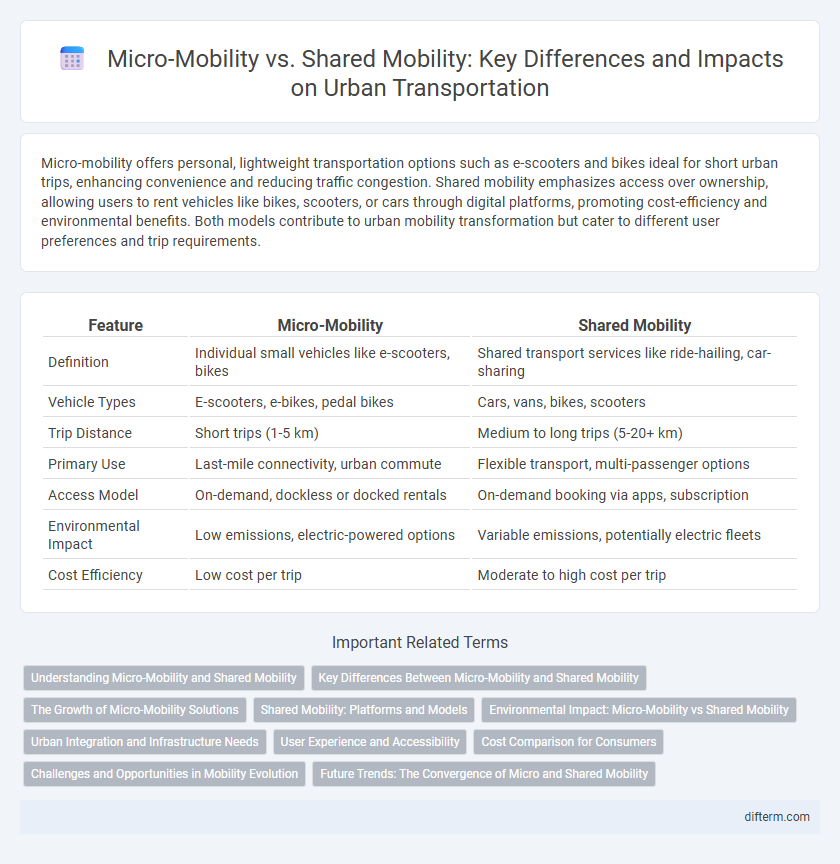Micro-mobility offers personal, lightweight transportation options such as e-scooters and bikes ideal for short urban trips, enhancing convenience and reducing traffic congestion. Shared mobility emphasizes access over ownership, allowing users to rent vehicles like bikes, scooters, or cars through digital platforms, promoting cost-efficiency and environmental benefits. Both models contribute to urban mobility transformation but cater to different user preferences and trip requirements.
Table of Comparison
| Feature | Micro-Mobility | Shared Mobility |
|---|---|---|
| Definition | Individual small vehicles like e-scooters, bikes | Shared transport services like ride-hailing, car-sharing |
| Vehicle Types | E-scooters, e-bikes, pedal bikes | Cars, vans, bikes, scooters |
| Trip Distance | Short trips (1-5 km) | Medium to long trips (5-20+ km) |
| Primary Use | Last-mile connectivity, urban commute | Flexible transport, multi-passenger options |
| Access Model | On-demand, dockless or docked rentals | On-demand booking via apps, subscription |
| Environmental Impact | Low emissions, electric-powered options | Variable emissions, potentially electric fleets |
| Cost Efficiency | Low cost per trip | Moderate to high cost per trip |
Understanding Micro-Mobility and Shared Mobility
Micro-mobility refers to small, lightweight vehicles such as electric scooters, bikes, and e-bikes designed for short trips typically under five miles, providing flexible and efficient urban transportation. Shared mobility encompasses transportation services and resources like car-sharing, bike-sharing, and ride-hailing that allow users to access vehicles on-demand without ownership, promoting reduced traffic congestion and environmental impact. Understanding the distinctions and integration of micro-mobility and shared mobility solutions is essential for developing sustainable, multimodal urban transit systems.
Key Differences Between Micro-Mobility and Shared Mobility
Micro-mobility typically involves small, lightweight vehicles such as electric scooters, bicycles, and skateboards designed for short-distance urban travel, emphasizing personal, individual use. Shared mobility encompasses a broader range of transportation options, including car-sharing, ride-hailing, bike-sharing, and public transit, focused on communal access and reducing vehicle ownership. Key differences include vehicle type, trip length, cost structure, and user experience, with micro-mobility favoring agility and sustainability, while shared mobility prioritizes convenience and accessibility.
The Growth of Micro-Mobility Solutions
The growth of micro-mobility solutions such as e-scooters, e-bikes, and dockless bicycles is transforming urban transportation by offering convenient, eco-friendly options for short-distance travel. Micro-mobility addresses last-mile connectivity issues and helps reduce traffic congestion and carbon emissions in densely populated cities. Investment in micro-mobility infrastructure and integration with public transit systems is accelerating adoption and expanding shared mobility ecosystems worldwide.
Shared Mobility: Platforms and Models
Shared mobility platforms leverage digital technology to enable efficient access to transport options such as bikes, scooters, and cars, facilitating seamless urban mobility. Models like ride-sharing, carpooling, and vehicle rental optimize resource utilization and reduce congestion by promoting collective usage instead of private ownership. Integration of AI and data analytics in shared mobility platforms enhances user experience through personalized routing, dynamic pricing, and real-time availability updates.
Environmental Impact: Micro-Mobility vs Shared Mobility
Micro-mobility options such as electric scooters and bikes produce significantly lower carbon emissions per kilometer compared to shared mobility vehicles like ride-hailing cars or shared electric vehicles, reducing urban pollution and traffic congestion. Shared mobility improves resource efficiency by maximizing occupancy rates and minimizing the number of individually owned vehicles on the road, contributing to lower overall emissions when systems are well-optimized. Lifecycle analyses indicate that micro-mobility's environmental benefits depend heavily on factors like vehicle durability, charging infrastructure, and the mode of transportation replaced, highlighting the importance of integrating both solutions for sustainable urban mobility.
Urban Integration and Infrastructure Needs
Micro-mobility solutions such as e-scooters and bike-sharing systems require dedicated urban infrastructure like protected bike lanes and widespread charging stations to ensure safety and efficiency. Shared mobility services, including car-sharing and ride-hailing, depend heavily on optimized parking zones and digital platforms integrated with city traffic management systems to reduce congestion and improve accessibility. Urban integration for both models demands strategic planning that aligns mobility hubs with public transit networks to create seamless, multimodal transportation options.
User Experience and Accessibility
Micro-mobility offers enhanced accessibility through lightweight, easy-to-use vehicles like e-scooters and bikes, enabling users to navigate urban areas with greater flexibility and convenience. Shared mobility platforms prioritize user experience by integrating seamless app interfaces, real-time vehicle availability, and optimized routes to reduce wait times and increase efficiency. Both modalities strive to improve urban mobility, but micro-mobility excels in personalized control, while shared mobility emphasizes widespread access and cost-effectiveness.
Cost Comparison for Consumers
Micro-mobility options such as e-scooters and bike-sharing typically offer lower per-trip costs compared to shared mobility services like ride-hailing and car-sharing, which often include higher base fares and surge pricing. Consumers save on last-mile travel expenses with micro-mobility due to minimal rental fees and flexible short-distance usage. Shared mobility services provide convenience but generally incur greater cumulative costs over time, making micro-mobility a more economical choice for frequent, short urban commutes.
Challenges and Opportunities in Mobility Evolution
Micro-mobility solutions like e-scooters and bike-sharing systems offer flexible, last-mile connectivity but face challenges in infrastructure integration and regulatory compliance. Shared mobility services, including ride-hailing and car-sharing, provide scalable urban transport options yet grapple with traffic congestion and sustainability concerns. The evolution of mobility hinges on addressing these issues by enhancing technology, fostering public-private partnerships, and optimizing urban planning for seamless multimodal ecosystems.
Future Trends: The Convergence of Micro and Shared Mobility
Future trends in urban transportation highlight the convergence of micro-mobility and shared mobility, creating integrated systems that enhance accessibility and reduce carbon emissions. Innovations in electric scooters, bikes, and autonomous shuttles are increasingly integrated into shared platforms, enabling seamless first- and last-mile connections. Data-driven mobility-as-a-service (MaaS) applications optimize route planning and vehicle availability, driving efficiency and user convenience in smart cities worldwide.
micro-mobility vs shared mobility Infographic

 difterm.com
difterm.com